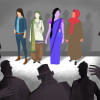We have all heard the saying, "What doesn't kill you makes you stronger." It's a comforting thought; the idea that struggle builds resilience. From childhood, we are taught to toughen up, speak out, and never let anyone walk all over us. Society loves a good comeback story; an underdog who fights back against the odds.
But what happens when someone cannot fight back? When they are too afraid, too powerless, or too trapped to resist? Do we offer them protection, or do we see their silence as permission?
That's the disturbing reality famous conceptual artist Marina Abramović exposed in her 1974 performance Rhythm 0, where she stood still for six hours letting the audience do whatever they wanted to her.
She gave them 72 items. Some relatively harmless, like a rose; others — pretty dangerous, like a loaded gun. What happened next is both fascinating and terrifying. At first, people interacted with her gently, maybe out of curiosity or hesitation. But as the minutes ticked by, things got... darker!
Some started cutting her, tearing her clothes, and pointing the gun at her head. It was as intense as it sounds. For Marina Abramović, it was all about pushing boundaries and testing human nature. And let me tell you, human nature, when there are no rules, can get pretty ugly.
Her stillness was an invitation, but it was not to kindness — it was an invitation to exploit, control, and (sadly) hurt. So, this leads to an interesting question: why does society seem to have a thing for punishing people who just do not fight back?
Rhythm 0 was not just an art performance — it was a chilling reflection of how power works in the real world. The way her audience escalated from kindness to cruelty mirrored how vulnerable people — especially women — are treated every day.
In Bangladesh and beyond, real-life stories echo this unsettling truth: when someone does not fight back, society often punishes them instead of protecting them.
For many women, Rhythm 0 is not an art experiment — it's life. They are expected to be accommodating, submissive, and endlessly patient. But if they actually stay quiet and endure mistreatment? They are seen as weak and undeserving of protection. If they push back? They are labelled difficult, dramatic, or "not knowing their place." It's a lose-lose situation.
Let's step away from the art gallery and into reality, where women have faced their own "Rhythm 0" — except in their cases, there was no time limit, no artistic experiment, just life itself.
Take domestic violence, for example. A woman trapped in an abusive relationship is not staying because she enjoys it — she's often financially dependent, afraid for her safety, or terrified of social stigma.
Yet, the first question society asks is: "Why didn't she just leave?" instead of "Why did he hurt her?"
Sounds familiar?
It's the same twisted logic from Rhythm 0 — blaming the victim's passivity instead of holding the perpetrator accountable.
Or, consider street harassment. If a woman in Bangladesh walks through a crowded street, chances are she has experienced some form of harassment—a catcall, an inappropriate comment, a lingering stare. Many women learn early that engaging with harassers can be dangerous, so they keep walking, pretending they did not hear, or stay silent.
It's as if the world is running a never-ending Rhythm 0 experiment, testing how much a woman will endure before she breaks.
One of the biggest lies society tells is that if someone does not fight back, they must be okay with what's happening. That's why sexual assault victims are asked, "Did you say no loudly enough?" and workplace harassment survivors are told, "Why didn't you report it sooner?"
Well, fear, shock, and power imbalances can paralyze people. That does not mean they are consenting — it means they are trapped. Just like Marina Abramović stood frozen while strangers inflicted harm, many victims feel unable to resist in the moment. That does not make the abuse acceptable.
And yet, this mindset is baked into our culture. Women who tolerate mistreatment in relationships are scolded for not leaving sooner. Those who suffer in silence at work are accused of making things up if they eventually speak out. The idea that vulnerability is an invitation to harm is not just false — it's dangerous.
These things are everyday realities for women across the world. And they all point to a disturbing pattern — when women endure abuse, they are blamed for not leaving; when women ignore harassment, they are punished for not responding; when women finally speak up, they are doubted for waiting too long.
In the same way, Abramović's audience escalated their actions the longer she stayed silent, real-life power imbalances allow abuse to grow when there are no consequences. Rhythm 0 may have been a six-hour experiment, but for many women, it's a lifetime reality.
Vulnerability is not an invitation for harm. Silence is not permission. The longer we allow power to go unchecked, the more people will take advantage of it. So, here's the challenge: will we keep watching from the sidelines, or will we finally step in and demand change? The next victim of this cruel cycle might be closer than we think—are we ready to act before it's too late?









Comments